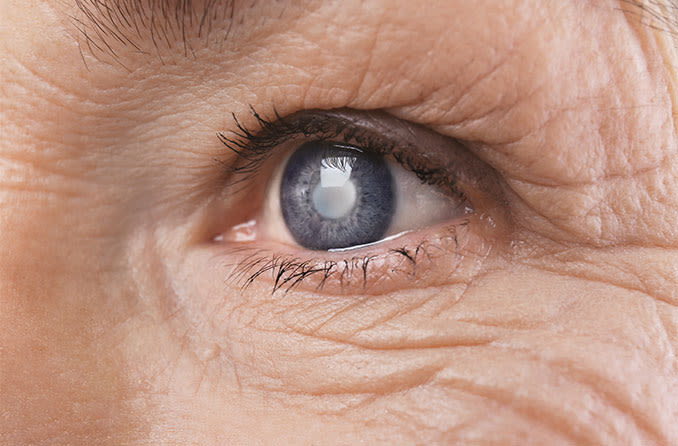Cataracts are the leading cause of blindness in the world. They occur when the lens of the eye is cloudy and can be present at birth or as a result of injury or aging. Symptoms are varied and may include, among other indications, blurred vision, cloudy vision, light sensitivity and double vision. And while more than half of all Americans will have cataracts by age 80, cataracts are treatable. Early detection and treatment are key.
If it turns out you need surgery for cataracts, the procedure is outpatient and takes less than an hour. During the surgery, the doctor removes the cloudy lens and replaces it with an artificial lens. After this routine procedure, your doctor might recommend an eye patch and an eye drop prescription to prevent infection. Your vision should improve within a few days and within eight weeks your eye should be fully healed. If it ends up that you need surgery for cataracts in both eyes, surgeries are usually scheduled for separate days.
Signs and symptoms of cataracts include:
- Clouded, blurred or dim vision
- Increasing difficulty with vision at night
- Sensitivity to light and glare
- Need for brighter light for reading and other activities
- Seeing “halos” around lights
- Frequent changes in eyeglass or contact lens prescription
- Fading or yellowing of colors
- Double vision in a single eye
At first, the cloudiness in your vision caused by a cataract may affect only a small part of the eye’s lens and you may be unaware of any vision loss. As the cataract grows larger, it clouds more of your lens and distorts the light passing through the lens. This may lead to more-noticeable symptoms.
General tips for keeping your eyes healthy:
1. Schedule regular eye checkups, and make sure you keep these important appointments!
2. Call your eye doctor before your annual visit if you have noticeable changes in your vision or changes in the look of your eyes (such as a changes in the color of the iris).
3. Visit your family physician to make sure high blood pressure and diabetes are being monitored and treated, as both can affect vision.
4. Wear sunglasses when outdoors to protect your eyes from harmful UV rays.
5. Include fruits, dark green vegetables, omega-rich fish, pork, eggs, nuts and beans in your diet.
6. Don’t smoke.
7. Wear safety googles or protective glasses for hobbies and sports.
Cataract types include:
- Cataracts affecting the center of the lens (nuclear cataracts): A nuclear cataract may at first cause more nearsightedness or even a temporary improvement in your reading vision. But with time, the lens gradually turns more densely yellow and further clouds your vision. As the cataract slowly progresses, the lens may even turn brown. Advanced yellowing or browning of the lens can lead to difficulty distinguishing between shades of color.
- Cataracts that affect the edges of the lens (cortical cataracts): A cortical cataract begins as whitish, wedge-shaped opacities or streaks on the outer edge of the lens cortex. As it slowly progresses, the streaks extend to the center and interfere with light passing through the center of the lens.
- Cataracts that affect the back of the lens (posterior subcapsular cataracts): A posterior subcapsular cataract starts as a small, opaque area that usually forms near the back of the lens, right in the path of light. A posterior subcapsular cataract often interferes with your reading vision, reduces your vision in bright light, and causes glare or halos around lights at night. These types of cataracts tend to progress faster than other types do.
- Cataracts you’re born with (congenital cataracts): Some people are born with cataracts or develop them during childhood. These cataracts may be genetic, or associated with an intrauterine infection or trauma.These cataracts may also be due to certain conditions, such as myotonic dystrophy, galactosemia, neurofibromatosis type 2 or rubella. Congenital cataracts don’t always affect vision, but if they do, they’re usually removed soon after detection.
When to see a doctor?
Make an appointment for an eye exam if you notice any changes in your vision. If you develop sudden vision changes, such as double vision or flashes of light, sudden eye pain, or sudden headache, see your doctor right away.
Call 911 if you believe you are experiencing a medical emergency. Certain eye-related issues, including sudden loss of vision, changes in vision, seeing flashes of light, etc., require emergency medical attention.
Remember, there are many things you can do to protect your vision. Make healthy eyes a priority!
Disclaimer: Health experts suggest that you talk to your doctor before you start, change or modify your medications, lifestyle or current treatment regimen.
Picture credit: https://www.allaboutvision.com/conditions/cataracts.htm
References
Boyd, K. (2022). What are Cataracts? Retrieved from https://www.aao.org/eye-health/diseases/what-are-cataracts
Cataracts. Mayo Clinic (2022). Retrieved from https://www.mayoclinic.org/diseases-conditions/cataracts/symptoms-causes/syc-2035379
Cataracts. Retrieved from https://www.hopkinsmedicine.org/health/conditions-and-diseases/cataracts

